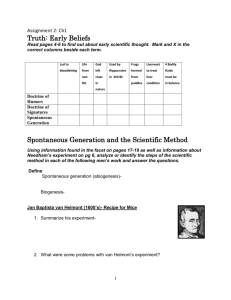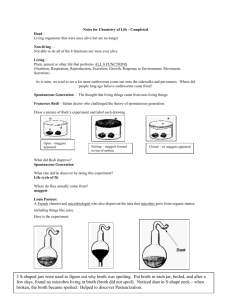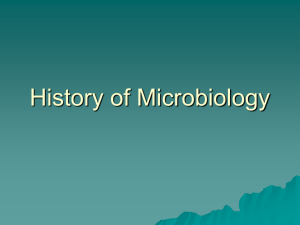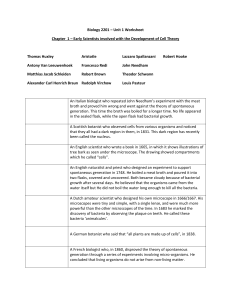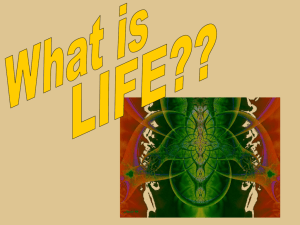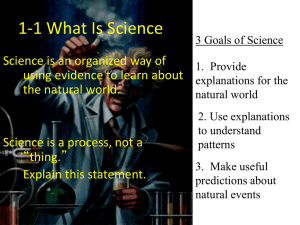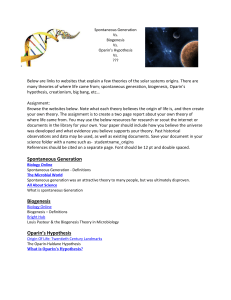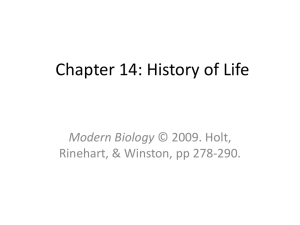Origins of Life
advertisement
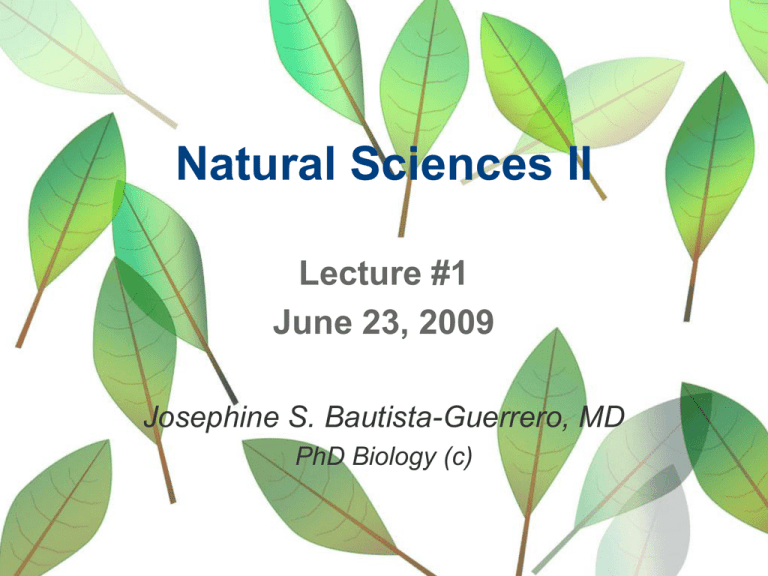
Natural Sciences II Lecture #1 June 23, 2009 Josephine S. Bautista-Guerrero, MD PhD Biology (c) What is a “Fact” and What is a “Theory”? Excerpt from: Scott, Eugenie C. 1996. Dealing with Antievolutionism. In Learning from the Fossil Record. A Fact • • • • Is a confirmed observation Implies TRUTH May change Is accepted and can be used as a given to build more complex understanding Examples of FACTS • Every tetrapod has – A humerus – A radius and ulna – Carpals, metacarpals and phalanges Examples of FACTS • Homo sapiens was thought to have 48 chromosomes A Theory • Is a logical construct of facts and hypotheses that attempt to explain a natural phenomenon • Is an EXPLANATION • (Theory formation) Is the goal of science What is Natural Science? Natural Science • Pertains to nature • Earth and Life Sciences – vs. Physical sciences – vs. Social sciences – vs. Formal sciences (a priori) Natural Science • Naturalistic approach to studying the universe “The doctrine that nature is all there is.... ... Is based on naturalism”. - Johnson, Reason in the Balance “Science is the search for the best naturalistic theories...” ... where a naturalistic theory abjures supernatural causes. Scientism “Science is the arbiter of all knowable truth, that there is nothing to be known beyond what science delivers.” Religion vs. Science • Science is not committed to the nonexistence of God. • Science is committed to naturalistic explanations. • Science does not count any explanation that appeals to God or to supernatural phenomena as a scientific explanation. 1. 2. 3. 4. 5. Creationism Interplanetary or Cosmozoic theory The Big Bang Theory Spontaneous Generation Biogenesis *Intelligent Design *The Anthropic Principle Life, humanity and all beings on earth were created by a supernatural being Opposes evolution because of the belief that beings are “perfect” in their form and were created as such Holds that the Genesis is infallibly true Directly contradicts the Big Bang Theory and the Theory of Evolution Creationism is a scientific theory and should be taught in the science curriculum as a competitor to the theory of evolution. The Cosmozoic Theory: Meteors containing life? Are we rejects from another planet? Intelligent Design Paley “God’s Design could be seen in life...” John Wheeler "A life-giving factor lies at the centre of the whole machinery and design of the world." The Anthropic Principle Proposed by astrophysicist and cosmologist Brandon Carter from Cambridge University in 1973 Presented at a conference held in Poland to celebrate the 500th birthday of the father of modern astronomy, Nicolaus Copernicus The Anthropic Principle "... the Anthropic Principle says that the seemingly arbitrary and unrelated constants in physics have one strange thing in common--these are precisely the values you need if you want to have a universe capable of producing life." Patrick Glynn The Anthropic Principle Gravity Electromagnetism Nuclear force Mass of atomic particles Properties of water Carbon Significant Events in the Formation of Life 1. 2. 3. 4. 5. 6. 7. 8. 9. Big Bang Theory Condensation of Swirling gases into a solid mass Formation of simple molecules – H2O, O2, N2, CH4, NH3 Formation of Biomolecules – carbohydrates, fatty acids, proteins, nucleotides Formation of Coacervates Formation of the first heterotroph prokaryote Formation of the first autotrophic prokaryote Formation of the eukaryotic cell Formation of the multicellular organisms Work by Miller and Oparin The Coacervate Theory • Colloidal suspension of macromolecules • May have properties that enabled them to form protocells • Due simply to physical and chemical phenomena; not selective Characteristics of Coacervates 1. Identity – each one has a unique mixture of biomolecules; properties of clay 2. A water film acts as a barrier like a cell membrane 3. Grows in size 4. When large enough, it breaks down into small globules with the same traits as that of the “parent” Spontaneous Generation vs. Biogenesis 1. Aristotle 2. Jean Baptiste Von Helmont 3. Anton von Leeuwenhoek 4. John Needham 1. Francesco Redi 2. Lazarro Spallanzani 3. Louis Pasteur Aristotle for Spontaneous Generation • Observed the similarity of inanimate environmental structures with semblance to certain living things (geese from trees, lambs from melons) • This theory is based on philosophical concepts and limited scientific facts and instrumentation Von Helmont for Spontaneous Generation • Wheat kernels + dirty shirt + 21 days = mice • Appearance of maggots in meat • Appearance of beetles and wasp in cow dung • Appearance of mice from caked mud Francesco Redi for Biogenesis • No maggots grew on container with full covering • Set-up covered with cheese cloth still developed maggots on meat Leeuwenhoek for Spontaneous Generation • Invented the microscope and observed small moving forms he called animalcules. • Observed in dirty canal water and teeth scrapings John Needham for Spontaneous Generation • Boiled meat broth transferred container incubate cloudy broth • Conclusion: Broth gave rise to animalcules Spallanzani for Biogenesis • Repeated the experiment of John Needham with two difference: (a) container was covered and (b) the broth not transferred • No growth was observed • Argument from scientist supporting spontaneous generation: The cover prevented the essence of life from the air to cause life to form in the container Louis Pasteur for Biogenesis • • • • Used a swan neck flask The broth was boiled and allowed to cool No growth Water trapped in the neck prevent microbes from contaminating the broth Manifestation of Life 1. 2. 3. 4. 5. 6. Cellular Organization Metabolism Reproduction Growth Responsiveness or Irritability Development or Evolution Levels of Organization • • • • • Systems Biosphere Ecosystem Community Population Multi-cellular and single cell organisms Organs Tissue Cells Organelle Molecules Atoms Subatomic particles
